Page 11 of 321

All adults, and children who have
outgrown child saf ety seats, are
wearing their seat belts and
wearingthemproperly(seepage).
Any inf ant or small child is
properly restrained in a child seat
inthebackseat(seepage ).
To make sure you and your
passengers get the maximum
protection f rom your car’s saf ety
f eatures, check the f ollowing each
time before you drive away:
The rest of this section gives more
detailed inf ormation about how you
can maximize your saf ety.
Remember, however, that no saf ety
system can prevent all injuries or
deaths that can occur in severe
crashes, even when seat belts are
properly worn and the airbags deploy.
All cargo is properly stored or
secured (see page ).
All doors are closed and locked
(see page ).
Head restraints are properly
adjusted (see page ).
Seat-backs are upright (see page
).
Frontseatoccupantsaresitting
upright and as f ar back as possible
f rom the steering wheel and
dashboard (see page ).
16 13
13
22 15
16
173
Pre-Drive Saf ety Checklist
Your Car’s Saf ety Features
Driver and Passenger Saf ety12
Page 12 of 321
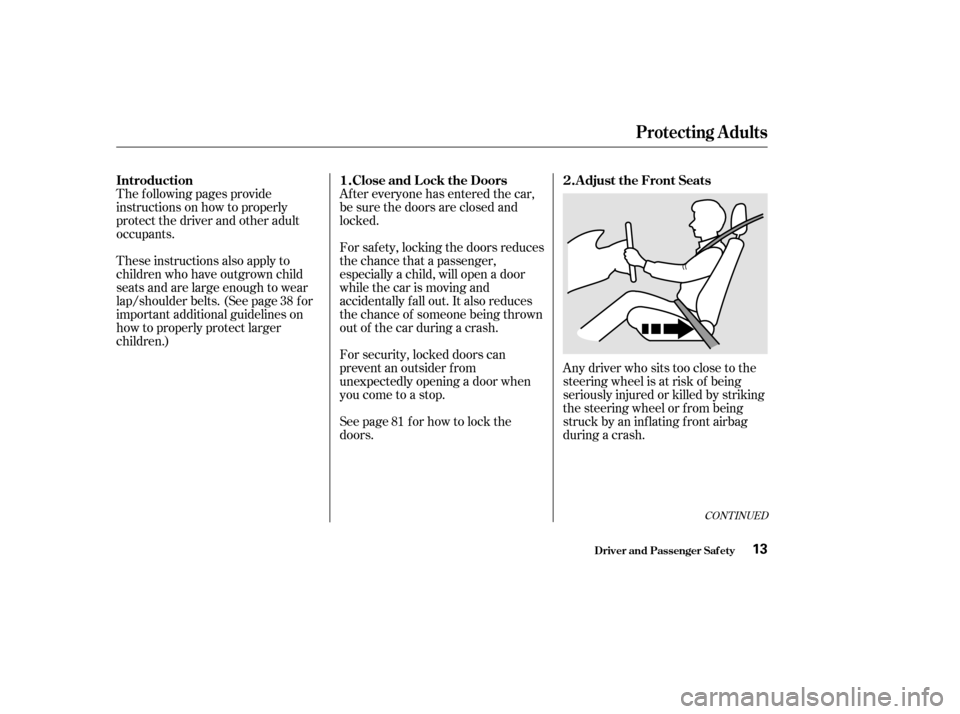
The f ollowing pages provide
instructions on how to properly
protect the driver and other adult
occupants.
These instructions also apply to
children who have outgrown child
seats and are large enough to wear
lap/shoulder belts. (See page f or
important additional guidelines on
how to properly protect larger
children.)Any driver who sits too close to the
steering wheel is at risk of being
seriously injured or killed by striking
the steering wheel or f rom being
struck by an inflating front airbag
during a crash.
Af ter everyone has entered the car,
be sure the doors are closed and
locked.
For saf ety, locking the doors reduces
the chance that a passenger,
especially a child, will open a door
while the car is moving and
accidentally f all out. It also reduces
the chance of someone being thrown
out of the car during a crash.
For security, locked doors can
prevent an outsider f rom
unexpectedly opening a door when
you come to a stop.
See page f or how to lock the
doors.
38
81
CONT INUED
Introduction A djust the Front Seats
Close and L ock the Doors
1. 2.
Protecting Adults
Driver and Passenger Saf ety13
Page 15 of 321
Bef ore driving, make sure everyone
with an adjustable head restraint has
properly positioned the head
restraint. The restraint should be
positioned so the back of the
occupant’s head rests against the
center of the restraint. A taller
person should adjust the restraint as
high as possible.Properly adjusted head restraints
will help protect occupants f rom
whiplash and other crash injuries.
See page f or how to adjust the
head restraints.Insert the latch plate into the buckle,
then tug on the belt to make sure the
belt is securely latched. Also check
that the belt is not twisted, because a
twisted belt can cause serious
injuries in a crash.
90
Adjust the Head Restraints
Fasten and Position the Seat
Belts
4.
5.
Driver and Passenger Saf ety
Protecting Adults
16
Improperly positioning head
restraints reduces their
effectiveness and you can be
seriously injured in a crash.
Make sure head restraints are
in place and positioned properly
before driving.
Page 24 of 321
To remind you of the f ront airbag
hazards, your car has warning labels
on the driver’s and f ront passenger’s
visors. Please read and f ollow the
instructions on these labels.Your car has three seating positions
in the back seat where children can
be properly restrained.
If you ever have to carry more than
three children in your car:
Place the largest child in the f ront
seat, provided the child is large
enough to wear a seat belt
properly (see page ).
Move the vehicle seat as far to the
rear as possible (see page ).
Have the child sit upright and well
backintheseat(seepage ).
Make sure the seat belt is properly
positioned and secured (see page ). 38
13
19
16
Protecting Children
Driver and Passenger Saf ety
If You Must Drive with Several
ChildrenCanadian Models
25
Page 28 of 321
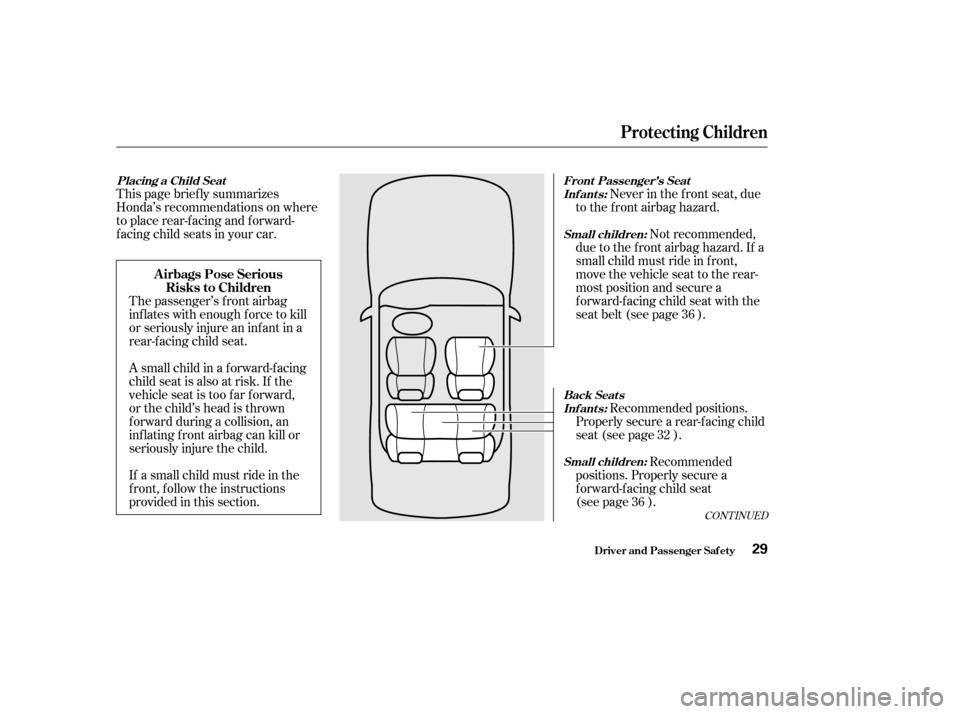
This page brief ly summarizes
Honda’s recommendations on where
to place rear-facing and forward-
f acing child seats in your car.Never in the f ront seat, due
to the f ront airbag hazard.
The passenger’s f ront airbag
inf lates with enough f orce to kill
or seriously injure an inf ant in a
rear-facing child seat.
A small child in a f orward-f acing
child seat is also at risk. If the
vehicle seat is too f ar f orward,
or the child’s head is thrown
f orward during a collision, an
inf lating f ront airbag can kill or
seriously injure the child.
If a small child must ride in the
f ront, f ollow the instructions
provided in this section. Recommended positions.
Properlysecurearear-facingchild
seat (see page ). Not recommended,
due to the f ront airbag hazard. If a
small child must ride in f ront,
move the vehicle seat to the rear-
most position and secure a
forward-facing child seat with the
seat belt (see page ).
Recommended
positions. Properly secure a
forward-facing child seat
(see page ). 36
32
36
CONT INUED
Placing a Child Seat Front Passenger’s Seat
Inf ant s:
Back Seat sInf ant s:
Small children:
Small children:
Airbags Pose SeriousRisks to Children
Protecting Children
Driver and Passenger Saf ety29
Page 29 of 321
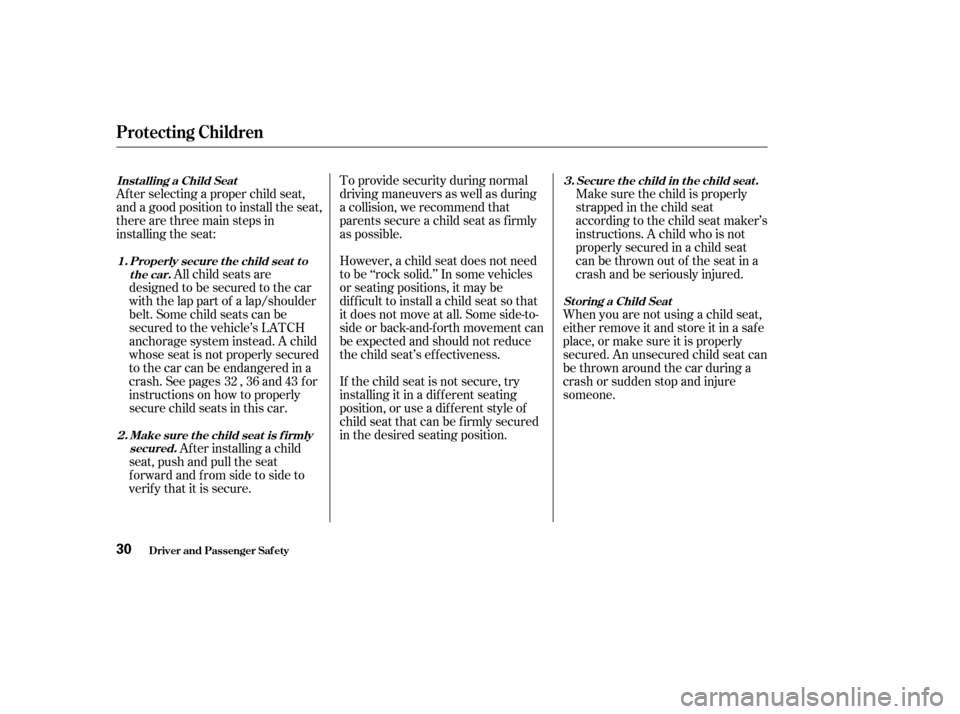
Af ter selecting a proper child seat,
and a good position to install the seat,
there are three main steps in
installing the seat:Make sure the child is properly
strappedinthechildseat
according to the child seat maker’s
instructions. A child who is not
properly secured in a child seat
canbethrownoutof theseatina
crash and be seriously injured.
To provide security during normal
driving maneuvers as well as during
a collision, we recommend that
parents secure a child seat as f irmly
as possible.
If the child seat is not secure, try
installing it in a dif f erent seating
position, or use a dif f erent style of
child seat that can be f irmly secured
in the desired seating position. When you are not using a child seat,
either remove it and store it in a saf e
place, or make sure it is properly
secured. An unsecured child seat can
be thrown around the car during a
crash or sudden stop and injure
someone.
However, a child seat does not need
to be ‘‘rock solid.’’ In some vehicles
or seating positions, it may be
dif f icult to install a child seat so that
it does not move at all. Some side-to-
side or back-and-f orth movement can
be expected and should not reduce
the child seat’s ef f ectiveness.
Af ter installing a child
seat, push and pull the seat
f orward and f rom side to side to
verif y that it is secure. All child seats are
designed to be secured to the car
with the lap part of a lap/shoulder
belt. Some child seats can be
secured to the vehicle’s LATCH
anchorage system instead. A child
whose seat is not properly secured
to the car can be endangered in a
crash. See pages , and for
instructions on how to properly
secure child seats in this car. 43
32 36
Inst alling a Child Seat Secure t he child in t he child seat .
Storing a Child Seat
Make sure t he child seat is f irmly secured.
Properly secure t he child seat t o
the car.
1.
2. 3.
Protecting Children
Driver and Passenger Saf ety30
Page 31 of 321
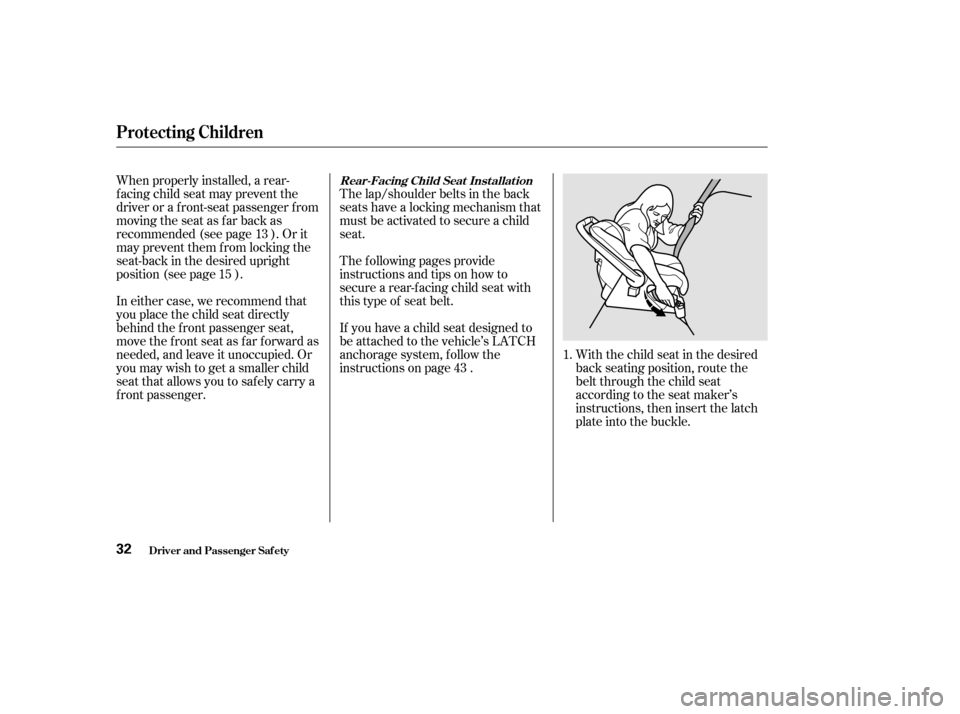
With the child seat in the desired
back seating position, route the
belt through the child seat
according to the seat maker’s
instructions, then insert the latch
plate into the buckle.
The lap/shoulder belts in the back
seats have a locking mechanism that
must be activated to secure a child
seat.
The f ollowing pages provide
instructions and tips on how to
secure a rear-f acing child seat with
this type of seat belt.
When properly installed, a rear-
f acing child seat may prevent the
driver or a f ront-seat passenger f rom
moving the seat as far back as
recommended (see page ). Or it
may prevent them f rom locking the
seat-back in the desired upright
position (see page ).
In either case, we recommend that
you place the child seat directly
behind the f ront passenger seat,
move the front seat as far forward as
needed, and leave it unoccupied. Or
you may wish to get a smaller child
seat that allows you to safely carry a
f ront passenger.
If you have a child seat designed to
be attached to the vehicle’s LATCH
anchorage system, follow the
instructions on page .
1.
13
15
43
Rear-Facing Child Seat Inst allat ion
Protecting Children
Driver and Passenger Saf ety32
Page 32 of 321
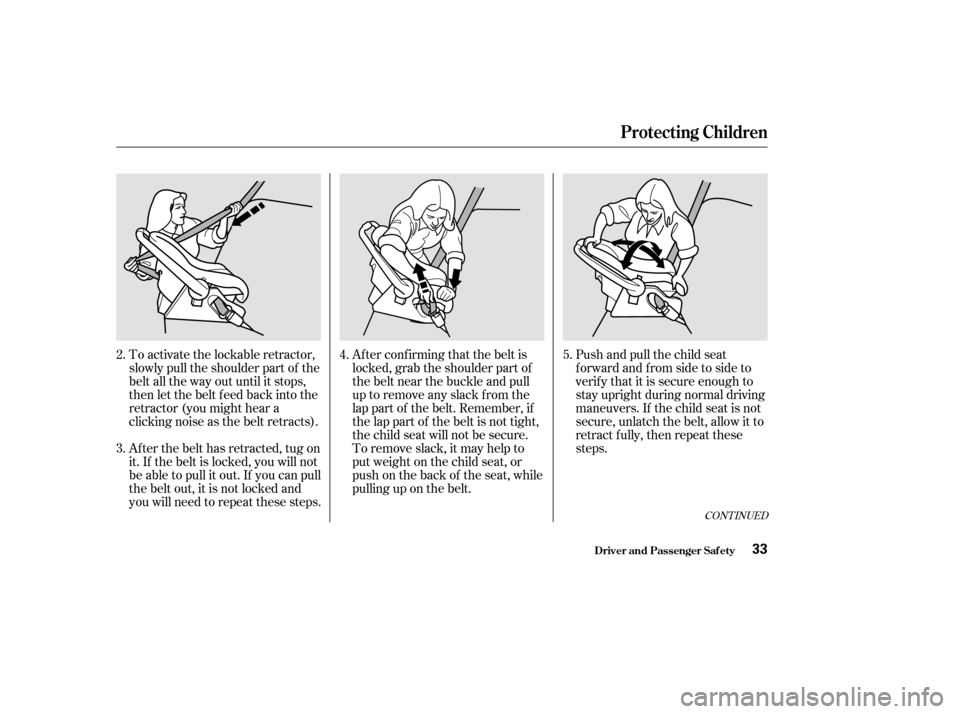
Push and pull the child seat
f orward and f rom side to side to
verif y that it is secure enough to
stay upright during normal driving
maneuvers. If the child seat is not
secure, unlatch the belt, allow it to
retract f ully, then repeat these
steps.
Af ter conf irming that the belt is
locked, grab the shoulder part of
the belt near the buckle and pull
up to remove any slack from the
lap part of the belt. Remember, if
the lap part of the belt is not tight,
the child seat will not be secure.
To remove slack, it may help to
putweightonthechildseat,or
push on the back of the seat, while
pulling up on the belt.
To activate the lockable retractor,
slowly pull the shoulder part of the
belt all the way out until it stops,
then let the belt f eed back into the
retractor (you might hear a
clicking noise as the belt retracts).
Af ter the belt has retracted, tug on
it. If the belt is locked, you will not
be able to pull it out. If you can pull
the belt out, it is not locked and
you will need to repeat these steps. 4.
5.
2. 3.
CONT INUED
Protecting Children
Driver and Passenger Saf ety33